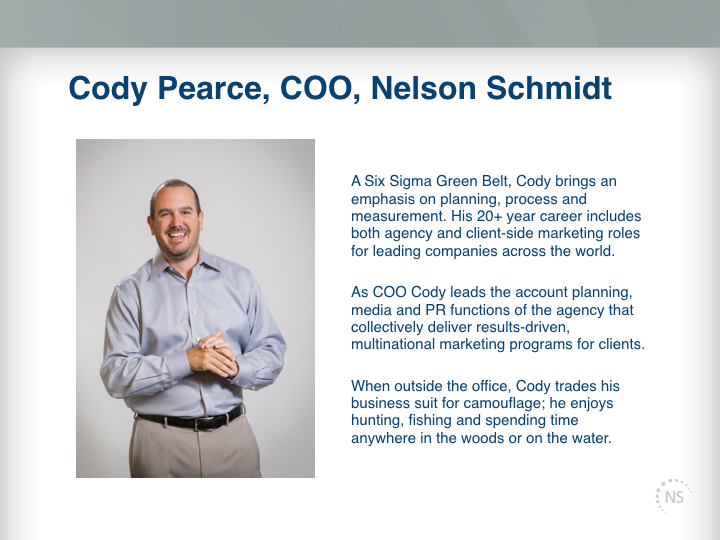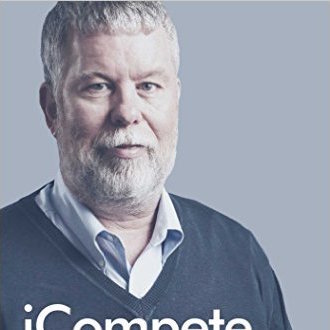Q&A: Cody Pearce, Chief Operating Officer of Nelson Schmidt, On An Evolution in B2B Marketing
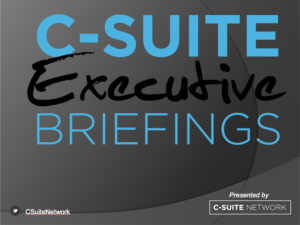
The C-Suite Network hosts a monthly online event called Executive Briefings. Each event features an executive thought leader discussing a topic important to the C-Suite. Thomas White, CEO of C-Suite Network, hosts the event with a unique Q&A format.
During one of our recent Briefings, Cody Pearce, chief operating officer of Nelson Schmidt, joined us to discuss the evolution and landscape, both present and future, of B2B marketing. Nelson Schmidt is a leader in helping companies and clients truly think about the marketplace and how they can engage with buyers in a way that’s really effective both to the top and bottom line.
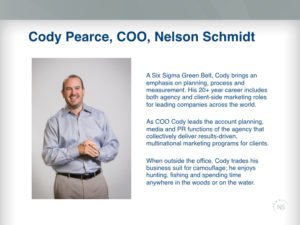
If anybody has been around marketing they’ve heard a couple of terms: B2B and B2C. So when somebody is talking about business to business, or B2B, what does that really mean?
We talk a lot about the evolution of B2B marketing and to some extent the dissolving of B2B marketing. When we look out at some of the trends that we’re monitoring, we look at three things: One, the market landscape has really dynamically changed even over the last three to five years. Just about every business model has been significantly disrupted. There is a massive influx of information and information technology that is changing the way we do business – changing the way we go to market.
Secondly, the customer landscape – both demographically and the way the customer has been empowered – are dramatically different because of the evolution of tools and information. The empowered customer has changed the way we think about marketing.
Lastly, the B2B landscape is dramatically shifting. We’ve seen a disappearance of our trade with the BMA (Business Marketing Association) being absorbed by the AMA (American Marketing Association) and with our Trade Voice BtoB Magazine being absorbed by Advertising Age, for example. Those trends are real evidence for us that there is a tremendous shift taking place, and a movement towards the creation of a single community of marketers rather than a definitive distinction between B2B and B2C companies, brands, and marketers. That shift, for us, is an incredibly important one, and one that we’re making sure to pay close attention to so we can change our business and our business practices with it.
We certainly have seen these changes in the landscape, the kind of things that we all supported and helped build this market we call B2B are certainly evolving pretty rapidly. What is causing this change? What is going on in the customer space that’s having this change come about?
What we look at, first and foremost, is the emergence of new channels and the access to information for customers that just hasn’t been there until the last three to five years in the way that it is today. That is changing the way the customers get information. It’s changing their ability to be much more intelligent and informed, and it’s forcing companies and marketers to think less about the product or solution they offer – a business or commercial audience versus a consumer one – and to think more about the journey and the considered purchase process of their customers. We need to evolve with these changing demographics, market landscape changes, and emergence of new tools and channels.
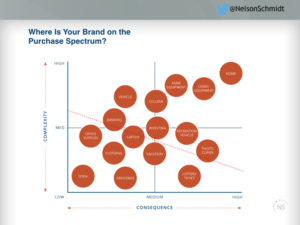
You talk about the change in how we market, but this question of the evolution of B2B to considered purchases isn’t really just an issue for marketing folks. It’s really an issue for all the C-Suite, isn’t it?
It really is. I think the changes that we’re starting to describe, and the trends that we’re looking at, it changes how we do business. It changes how we connect with customers. It changes, perhaps, how we go to market and make money. For us, as an agency, and as a considered purchase marketing agency, it means thinking differently about the way that we help our customers from the executive office all the way through the commercial marketing teams and into the sales organization. So it does affect our client’s businesses literally from top to bottom in the way that they do business.
You’ve used this term a few times called considered purchase, what does it mean?
It simply means that rather than defining marketing as business-to-business or business-to-consumer, we are defining our practice of marketing around the idea of the level of consideration we see that customers make before making a purchase choice. Considered purchases are complex and have a great deal of emotional and financial risk and reward.
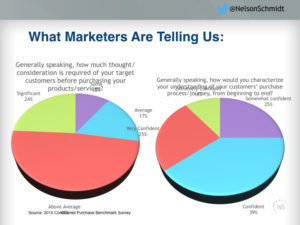
So you aren’t getting this idea because you sit around a room. You go out and talk to folks and find out from them what they’re seeing.
That’s absolutely right. It’s not just about coming up with a new term for the sake of having something catchy to talk about next. It really is about re-inventing the way that, as an agency, we’re beginning to practice and the way that we solve problems for our customers.
When we talk to marketers, what we’re hearing are a couple of emerging trends. Number one, we hear that there’s a lot more focus around the consideration for purchase of those goods or services. It’s less about B2C and B2B, and it’s more about the level of consideration a customer has to make before making a purchase choice. We also find that the marketers probably feel less informed, especially as business models change and are disrupted. We begin to then shape our conversation around the purchase journey, around the consideration required, and the consequence and complexity tied to a brand choice to define the way that we practice.
For example, if we start to look at and map different categories of products and services along a spectrum of consequence and complexity, we can start to draw a line differently than traditional B2B and B2C lines have been drawn in the past. There’s kind of a convergence and a similarity now between the process someone may go through when choosing a banking alternative or a college choice, and very much being able to connect that to what a capital equipment purchase might look like. That journey looks very similar regardless of a consumer or a business target audience or offering.
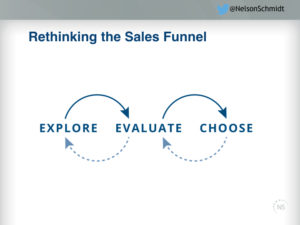
Do you think because we have had these distinctions of B2B, B2C, and so forth that we have failed to really understand what you call the customer journey and how the sales funnel really works?
Yes, and marketers tell us that. They’re starting to question the traditional sales funnel and rethink the way that customers, in a more informed setting along a path of highly considered purchase, are moving through that funnel in a less linear fashion. Instead, they are coming in and out of it much more rapidly, and carrying forward with them preconceived choices based on the level of information available to them. As we look at the customer journey in the highly considered purchase path, it forces us to rethink the sales funnel and how we engage with the customer to affect their choices.
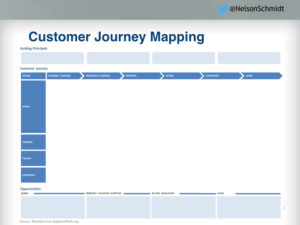
Let’s talk about the customer journey. How do you help people map that out?
We actually give a lot of credit to a company called Adaptive Path. We found some very compelling tools that this organization had developed. They are a thought leader in the space of customer experience, and they make available to us, and this is public domain, a great set of tools that we’re beginning to use to provide structure to mapping out the customer journey.
The tools help us look at the stages a customer goes through, whether it’s in a business-to-business or business-to-consumer setting. We then can map those stages out from decision, through research and shopping, into buying and consumption — all the way down to using and feeding back into the loop their experience.
Not only does this allow us to look at the functional aspects of what customers are doing, but it lets us explore the emotional aspects of what customers may be thinking, feeling, and experiencing at each of the stages of the journey. That allows us, ultimately, to provide some guiding principles and seek opportunities for where we can be most effective with the right content, at the right time, through the right channel, as we begin to map this more comprehensively.
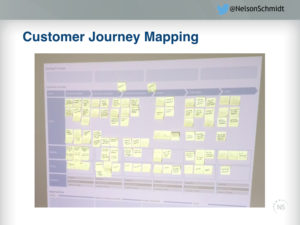
By mapping this out we know what to do when.
That’s right. It’s about what to do when. It’s about what channels to use. It’s about having some predictability in the work that we do to the outcomes that we’re trying to measure. This allows us to set up analytics and KPIs around our marketing programs to know that the investment is working as best as it can.
We begin to apply this as simply and as informally as a brainstorming session. We literally project it up on a wall for a post-it note session with our media and public relations and digital teams. We also take it very formally into the way that we scope and manage comprehensive annual campaigns.
Through this modeling we can start to look at the tools and the modes of communication. We can look at what customers are functionally doing, thinking, and feeling at each individual stage. We can much more intelligently then shape our messaging, our creative strategies, our channel mix, and investment in a way that we know is going to be most effective and optimized.
This guideline has given us a great framework to start looking at both consumer and commercial purchase cycles and building intelligent plans that use a modern set of tools in the most effective way.
What is the “Zero Moment of Truth”?
Zero moment of truth is something that has been talked about for a few years. This is the ultimate point in time in the customer journey of where they decide and make a final decision. It’s that moment of truth where we can start to look at the first moment of truth – that is when a customer narrows down its final set of consideration brands – and the zero moment of truth when they actually go from the shopping and evaluation to the choice. They have made a critical decision.
This model that you’re using is a considered purchase model. This could apply to what has traditionally been thought of as a business to business or a business to consumer orientation.
Yes, it doesn’t matter for us. For example, laundry machines. A laundromat owner may be considering replacing equipment in his or her store, or a homeowner may be looking to replace the washer and a dryer in their home. Both are highly considered purchases.
For both of those scenarios, we can map those purchase journeys. We start to model very closely the tools, the channels, the content, and the delivery of what we do as marketers to affect their choices.
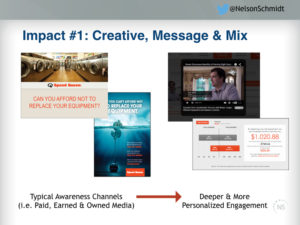
We’ve got this picture of the customer journey. Is this it or is there more?
No, there’s more. Obviously this is one step towards them building an effective brand and communications plan and strategy. The example that we will use here is connected to that laundry store owner. How it impacts what we then do as marketers can come in three ways and shapes.
Number one is this has dramatically impacted the way we are shaping and delivering our creative and message strategy that we’re using. We have typically focused heavily on the promotion of our functional benefits. We talk a lot about the value proposition. We talk about promoting features and benefits of a solution.
Now having gone through these exercises, it has completely changed that mindset for us. It lowered the purpose and the role of the equipment and it heightened the emotional feeling of risk and of challenge and connecting it to a broader set of solutions that our brand can deliver. In this case we talk about financing. We talk about construction services. We talk about the business that they’re running and the impact we can have on improving that business. We connect emotionally through digital platforms by showing and telling through much deeper engagement how that is happening, and what other customers are feeling, and how they can connect. The first impact it’s having is changing the way we build our message and creative strategies and the mix that we use.
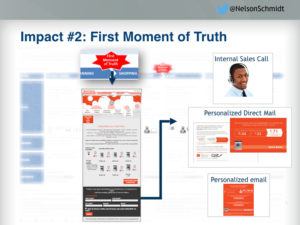
The second thing is these individual moments of truth. The great news is that marketing automation, programmatic media, CRM and other marketing techniques have dramatically improved our ability to intelligently hone in on this and very predictably insert the right content at exactly the right moment through the right channel, and keep that engagement to make sure that we are a part of that zero moment of truth. It has really changed the way that we bring automation and use technology to deliver our content in a much more sophisticated and predictable way.
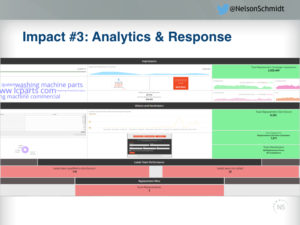
Lastly, it lets us build metrics that are a little bit different than the traditional KPIs of a marketing program. We can not only look at the things that are typical in the funnel in terms of impressions and the things that we usually have looked at as marketers. It starts to help us really hone in and drill down on activities where are we seeing engagement. Getting this in real time and connecting it down to the sales funnel, in terms of active deals and closed opportunities, lets us measure in real time how impactful our message, our mix, and our strategies are at being part of that consideration set.
Those three things to us as marketers are incredibly powerful. What we’re saying and when. How it is being delivered. The way that we hone in predictably on the behavior of consumers at exactly the right time. Then the visibility to measure that along the way to affect our decisions. Those are the three big ones for us.
What does all this mean to how we measure marketing effectiveness? It seems like we have a whole new way to look at things that are much more clearly tied to the sales results we’re producing.
Yes, that is probably the most important question marketers are asking themselves. They are looking at their investments and seeing pressure from the C-Suite in terms of what am I getting, what should I invest, and how are we performing. We owe it to ourselves as marketers – and frankly as an agency committed with a tagline of “we deliver customers” – we have to back that up with evidence.
We’re starting to talk about engagement versus the quantity of impression. Where we typically are thinking a lot about the top of the funnel in terms of impressions, awareness, and perception, and attitude measure – that matters and we care about it, but we also have to know what impact that is having on the quality of engagement – from the engagement of consideration, to ultimately the choice. Being able to connect that from the top of the funnel to the bottom of the funnel literally in terms of active deals through visibility in CRM and a connection to our customer sales teams, is critically important.
What does somebody do if they want to start bringing in this understanding of the customer journey in a considered purchase way but they don’t have a large budget? Where do they invest their money?
Frankly, what I would encourage is to go through the process I discussed earlier — go through a process of mapping the customer journey. Go through a process of truly, intimately understanding what your customers are going through in making their choices in a highly considered decision. Zone in on the areas where you feel you can affect that first and final moment of truth to bring your brand into consideration, and dominate and own that area of your marketing investment.
Regardless of the size of budget, being thoughtful about the approach and careful about the measurements can help you determine the right thing to do at any investment level.
Moving forward, what do people do?
We are hypothesizing here – based on the trends we’ve talked about and the evolution and witness of our B2B trade dissolving, we believe there’s an evolution taking place. We believe that organizing the way we practice around considered purchase versus B2B and B2C is a meaningful path. We believe that the playbook, the way that we deliver, should be centered on the mapping of that customer journey in a much more modern way with the use of the most sophisticated tools we have available to us as marketers.
We want to continue the dialogue. We want to continue to learn and listen to marketers. We want to invite everybody here to join in this conversation and debate. Let’s, as a community of marketers, regardless of B2C or B2B, begin to recognize truly how disrupted our space has become and how important it is for us to start moving in a direction to re-invent ourselves and redefine our impact in business value. That is critical for us and I think that is what we can all go forward thinking. We believe there is something relevant here for everyone to dig in with us.
You can learn more about Executive Briefings, watch other sessions and sign up for future events here.

Thomas White is the CEO of the C-Suite Network and the host of the nationally syndicated video program, Business Matters. This was taken from dialogue on C-Suite Executive Briefings.




